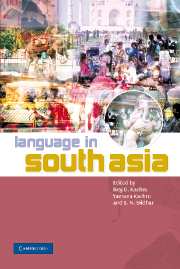Book contents
- Frontmatter
- Contents
- List of Figures
- List of Maps
- List of Tables
- Preface
- Acknowledgments
- List of Abbreviations
- Note on Transcription
- Introduction: languages, contexts, and constructs
- Part 1 Language history, families, and typology
- Part 2 Languages and their functions
- Part 3 Sanskrit and traditions of language study
- Part 4 Multilingualism, contact, and convergence
- Part 5 Orality, literacy, and writing systems
- Part 6 Language conflicts
- Part 7 Language and modernization
- 16 Language modernization in Kannada
- Part 8 Language and discourse
- Part 9 Language and identity
- Part 10 Languages in diaspora
- References
- Subject Index
- Language Index
- Author Index
16 - Language modernization in Kannada
Published online by Cambridge University Press: 04 May 2010
- Frontmatter
- Contents
- List of Figures
- List of Maps
- List of Tables
- Preface
- Acknowledgments
- List of Abbreviations
- Note on Transcription
- Introduction: languages, contexts, and constructs
- Part 1 Language history, families, and typology
- Part 2 Languages and their functions
- Part 3 Sanskrit and traditions of language study
- Part 4 Multilingualism, contact, and convergence
- Part 5 Orality, literacy, and writing systems
- Part 6 Language conflicts
- Part 7 Language and modernization
- 16 Language modernization in Kannada
- Part 8 Language and discourse
- Part 9 Language and identity
- Part 10 Languages in diaspora
- References
- Subject Index
- Language Index
- Author Index
Summary
Introduction
In this chapter, which continues and complements S. N. Sridhar (1988), I analyze the effects of modernization on Kannada, with special reference to the structure of the lexicon, syntax, and style repertoire.
Background
Kannada has a long and rich literary tradition, going back to at least the ninth century. The literature is primarily poetic, though there is relatively more prose than in many other literary languages of South Asia. The long cultivation of the language for literary purposes, together with a liberal attitude toward borrowing, has resulted in the formation of a rich and supple idiom. However, Kannada has but a sketchy (though ancient) tradition of scientific discourse (see Bhardwaja 1949 for an overview). For centuries, Sanskrit enjoyed hegemony as the premier language of intellectual discourse; Persian and Arabic dominated the spheres of law and administration during the eighteenth century, and the prestige and power of English led to a neglect of Kannada in the education system in the nineteenth century and the first half of the twentieth century. As a result, when Kannada intellectuals began to think of modernization toward the end of the nineteenth century, they found a language with a lopsided development: rich in the idiom of the humanities, but ill-equipped to serve as the vehicle of contemporary, Western-influenced intellectual, scientific, and technological discourse.
The beginning of the modernization movement in Kannada may be traced to the founding of the Karnataka Bha:sho:jji:vini: Sabha: (1886) under the auspices of the then Maharaja of Mysore, Sri Chamaraja Wodeyar.
- Type
- Chapter
- Information
- Language in South Asia , pp. 327 - 342Publisher: Cambridge University PressPrint publication year: 2008
- 1
- Cited by



